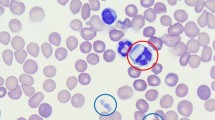Abstract.
This study describes transmission experiments using Hammondia heydorni-like oocysts isolated in 1996 from a naturally infected dog. The isolate was designated as H. heydorni-Berlin-1996. Examination of sera from infected intermediate hosts showed immunoblot reactions that resembled patterns observed after Neospora caninum NC-1 infection. Furthermore, N. caninum DNA could be demonstrated in tissue samples (e.g. heart, brain) of experimentally infected intermediate hosts and in oocyst preparations from H. heydorni-Berlin-1996. The isolated oocysts did not induce any detectable disease in any of the inoculated adult intermediate hosts (goats, sheep, gerbils, guinea pigs, multimammate rats, BALB/c mice, SCID mice), even upon immunosuppression. Furthermore, neither histological lesions nor parasite stages could be identified in the tissues of all fetuses recovered from two multimammate rats that had been infected prior to pregnancy. An experiment with one dog fed a second time on infected intermediate host tissue indicated that immunity may prevent repeated oocyst shedding in N. caninum-infected dogs. In addition, the study clearly demonstrates that N. caninum can be readily transmitted by dogs that have ingested exclusively skeletal muscles of infected intermediate hosts. Therefore, the study has consequences for the recommendations for farmers to prevent postnatal transmission of N. caninum to cattle. It indicates that feeding of any tissues of potential intermediate hosts (including sheep, goats, rodents) to final hosts may induce the shedding of oocysts in these hosts and thus pose a risk for post-natal infection of cattle. With respect to oocyst morphology and the infectivity of muscle tissues for final hosts, no differences were seen in comparison with observations made in the past on Isospora bigemina/I. heydorni/H. heydorni. Therefore, earlier studies made on I. bigemina/I. heydorni/H. heydorni have to be re-evaluated critically to determine whether they may have included N. caninum or other protozoan parasites that use dogs as final hosts and have an oocyst morphology resembling that of I. bigemina/I. heydorni/H. heydorni.
Similar content being viewed by others
Author information
Authors and Affiliations
Additional information
Electronic Publication
Rights and permissions
About this article
Cite this article
Schares, G., Heydorn, A., Cüppers, A. et al. Hammondia heydorni-like oocysts shed by a naturally infected dog and Neospora caninum NC-1 cannot be distinguished. Parasitol Res 87, 808–816 (2001). https://doi.org/10.1007/s004360100445
Received:
Accepted:
Issue Date:
DOI: https://doi.org/10.1007/s004360100445




